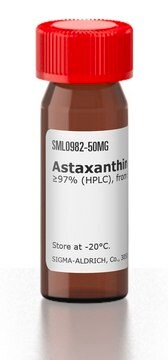14681
Zeaxanthin
analytical standard
Sinónimos:
β,β-Carotene-3,3′-diol
About This Item
Productos recomendados
grade
analytical standard
Quality Level
assay
≥95.0% (HPLC)
shelf life
limited shelf life, expiry date on the label
technique(s)
HPLC: suitable
gas chromatography (GC): suitable
application(s)
cleaning products
cosmetics
food and beverages
personal care
format
neat
storage temp.
−20°C
SMILES string
CC(=C/C=C/C=C(C)/C=C/C=C(C)/C=C/C1=C(C)C[C@@H](O)CC1(C)C)\C=C\C=C(C)\C=C\C2=C(C)C[C@@H](O)CC2(C)C
InChI
1S/C40H56O2/c1-29(17-13-19-31(3)21-23-37-33(5)25-35(41)27-39(37,7)8)15-11-12-16-30(2)18-14-20-32(4)22-24-38-34(6)26-36(42)28-40(38,9)10/h11-24,35-36,41-42H,25-28H2,1-10H3/b12-11+,17-13+,18-14+,23-21+,24-22+,29-15+,30-16+,31-19+,32-20+/t35-,36-/m1/s1
InChI key
JKQXZKUSFCKOGQ-QAYBQHTQSA-N
General description
Application
- Optimization of an ultrasonic-assisted extraction procedure for obtaining zeaxanthin and lutein from corn gluten meal samples for their determination by high-performance liquid chromatography-UV-Visible detection
- Simultaneous quantification of five carotenoids and two chlorophylls from soybean flour samples by reversed-phase high-performance liquid chromatographic (RP-HPLC) method combined with UV-Vis detector
- Multi-residue analysis of carotenoids and apocarotenoids in intact human blood samples by supercritical fluid extraction and supercritical fluid chromatography-atmospheric pressure chemical ionization-triple quadrupole mass spectrometry detection (SFE-SFC-APCI/QqQ/MS)
- High-performance liquid chromatography-diode array detector (HPLC-DAD) method-based determination of carotenoids in marigold flower and food supplement samples
- Profiling of carotenoids and their isomers in different plant tissue samples by high-performance liquid chromatography (HPLC) using a C30 column and photodiode array (PDA) detection
Biochem/physiol Actions
Packaging
Other Notes
Storage Class
11 - Combustible Solids
wgk_germany
WGK 1
flash_point_f
Not applicable
flash_point_c
Not applicable
ppe
Eyeshields, Gloves, type N95 (US)
Elija entre una de las versiones más recientes:
¿Ya tiene este producto?
Encuentre la documentación para los productos que ha comprado recientemente en la Biblioteca de documentos.
Los clientes también vieron
Artículos
All-trans retinoic acid (RA, ATRA) is a pleiotropic activation factor that regulates genes associated with normal vertebrate cellular processes such as cell differentiation, cell proliferation, apoptosis, and embryonic development.
Antioxidants protect biological systems from oxidative damage produced by oxygen-containing free radicals and from redoxactive transition metal ions such as iron, copper, and cadmium.
Protocolos
HPLC Analysis of Carotene Compounds on Ascentis® RP-Amide
Nuestro equipo de científicos tiene experiencia en todas las áreas de investigación: Ciencias de la vida, Ciencia de los materiales, Síntesis química, Cromatografía, Analítica y muchas otras.
Póngase en contacto con el Servicio técnico










